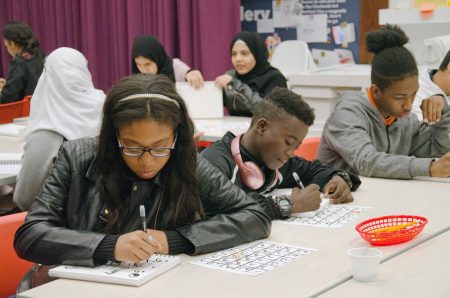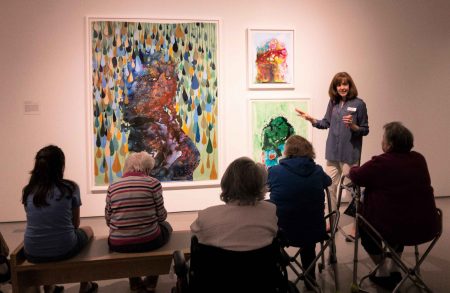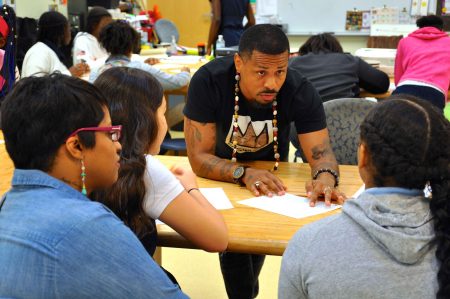“The city has room for three different art centers,” said Elise Solomon, director of learning and engagement at the Taft Museum of Art. Shawnee Turner, Elizabeth Hardin-Klink and Emily Holtrop, her counterparts at the Contemporary Arts Center (CAM) and the Cincinnati Art Museum (CAM) respectively would agree. Often under the radar, they all actively develop educational programs of a wide variety for visitors and collaborate to accomplish their goals, many of which include diversity.
One unique program all the educators work on is Memories in the Museum where the Alzheimer’s Association, Cincinnati Art Museum, Contemporary Arts Center and the Taft Museum of Art collaborate to create a program for visitors with memory loss and their caregivers. Representatives from each organization meet every spring to discuss themes, marketing and decide which museum the group will go to each month. They make this decision based on special exhibitions at the museums. The museums also work with the Alzheimer’s Association to plan annual training for docents who lead the tours.
There is a meet and greet followed by a tour and an art activity for this program held four times annually at every organization. As an education team, the group works together to determine which artists come in to lead the projects for Memories. For CAC, it is art on view. For example, in 2019, the CAC sponsored a session on the exhibitions on display at that time: paintings by Robert Colescott; photographs by Tom Schiff, architecture and an installation by Lauren Henkin. For Colescott, the discussion centered around the American Dream. The art activity was creating collector’s plates that featured visitors’ idea of the American Dream.
Turner, interpretive learning director at the CAC, said “As people progress with Alzheimer’s, their art and music functioning is the last to be affected, so people often have good reactions to programming that includes this. In the early to mid-stage, socialization is a great benefit.”
Holtrop, CAM’s director of learning and interpretation, said, “Visitors have a multisensory experience at the museum, meaning we use touchable objects as well as music and scents to help visitors create a conversation around the art. The tour is themed around a special exhibition or collection topic. The art making is based on the theme of the month. The results vary. This serves a diverse population by serving those who are underserved by the arts in our community.”
What Turner and her colleague Hardin-Klink, creative learning director, do is organize programs designed to not only educate adults, teens and children, but also introduce the public to a variety of experiences. They do this in a number of ways, including organizing a C-YA Teen Council, holding a young adult lab, recruiting artists-in-residence, hosting a school outreach program and sponsoring a homeschool program.
The School Outreach Program is a 36-year program that allows students at schools to visit CAC and engage with other arts opportunities. The program has two parts: a single and a multi-visit aspect. The single school visit allows 10-12 schools to receive free bus transportation to CAC for a field trip annually, according to Turner.
“The multi-visit school program allows ten schools to engage with a year-long program that involves an orientation, two CAC field trips, one artist’s visit to the school and one studio visit, all with free transportation,” said Turner.
Schools for this program are based on diversity, economic need and availability of arts programming. Artists who visit the classroom do projects that align with one of the exhibitions they see when they visit during one of their field trips, according to Turner. The schools have one to two docents they work with throughout the year.
Schools on the multi-visit program include Dater High School, Holy Family School, Chase Elementary School, Cincinnati College Preparatory Academy, Milford High School, Princeton High School, LEAP Academy, Silverton Paideia Academy, Newport High School and Winton Woods Primary North School. Artists who visit the classroom do projects that align with one of the exhibitions they see when they visit during one of their field trips.
Dater High School has a significant Guatemalan population. Holy Family School in Covington, Kentucky does not offer art programming. It has about 23% Hispanic/Latino student body of K – 8. Schools for this program are chosen based on diversity, economic need and availability of art programming.
CAC staff sends out an application for the program every spring for the following school year. Turner reviews the application and researches the school’s demographics, free/reduced lunch rate and Title 1 status. Teachers and principals complete questions on the application regarding art programming and need.
Educators administer the program, prepare materials for the programs, train docents, and create lesson plans.
CAC staff saw that many school-aged homeschool families attended programs geared for toddler and preschool visitors. As a result, they recognized that there was a need for homeschool programming and held meetings with families to gauge what the program might look like and used their knowledge and recommendations to develop and market the program, according to Hardin-Klink.
In 2014, after six months of meetings, Hardin-Klink launched Homeschool Wednesdays at CAC. It consists of a private tour of a CAC exhibition led by a CAC educator, following by an art making lesson that’s both inspired by the exhibition and incorporates cross-curriculum learning.
The homeschool program now sells out.
“In 2017 we moved to expand the program to libraries throughout Cincinnati and Northern Kentucky, allowing us to bring exhibition learning outside the galleries through interactive presentations and art-making,” she said. Libraries include Cheviot Branch Library, Harrison Branch Library, Walnut Hills Branch Library, Symmes Township Library, Greenhills Branch Library and Kentucky County Public Library – William E. Durr Branch.
“All of our homeschool programs tie in with CAC exhibitions,” said Hardin-Klink, “with the exception of the occasional field trip we do to a local artist studio or gallery. Between the CAC’s Homeschool Wednesdays and Homeschool Outreach, we see about 1,000 homeschoolers ages 6 – 12 a year. Demographics vary.” She estimated that 85% of students are white while 15% are minority students with an approximate breakdown of 50% male 50% female. Visitors come from as close as ten minutes away to as far as an hour’s distance.
Hardin-Klink counts the teen program as successful. There are now over 2,500 teens who come from across the Greater Cincinnati area to CAC. Bus passes help them travel to the Center to take advantage of the programs. There is diversity in age, race and economic background of young adults who range from 13 to their early 20’s. A teen council acts as a sounding board and has created an art prom, a student planned event for teens to party in a safe and accepting environment.
The original of the teen council began in 2013 when Hardin-Klink approached director Raphaela Platow about the possibility of starting such a program. With her support, Hardin-Klink began meeting with local art educators and surveying teen visitors to decide what model would best fit CAC. By 2014, the teen council began. It meets bimonthly and includes artmaking workshops. Students learn from both local artists and CAC exhibition artists about careers and life experiences in creative environments.
There was an immediate increase in teen attendance when admission to the museum became free in 2016. Staff members began to make changes to grow teen programming to adapt to the museum’s new audience.
The Institute of Museum and Library Sciences honored the CAC with a Museums for America award in 2018. This three-year grant allowed CAC to hire additional staff, expand young adult programming to three nights a week and provide an annual out-of-state field trip for C-YA members.
Hardin-Klink said CAC works hard to make sure that all teens feel welcome through simple, but intentional actions. CAC education staff is a strong advocate for teens, calling out microaggressions and discrimination when it occurs and educating visitors of all ages on the importance of showing respect to each other.
Teen membership forms and Teen Council applications include a space for students to state their preferred gender pronouns and preferred names.
CAC is a non-collecting arts center, not a museum, and focuses on contemporary art.
Behind the scenes of pictures and murals in the Taft Museum of Art is a busy education department headed by Solomon, who has a staff of four.
There are many aspects to education at the Taft. There are tours, Lunch and Learns, workshops, school programs and the Duncanson artist-in-residence which has attracted a diverse pool of candidates for the last 33 years. Last year, Ya’Ke Smith, a filmmaker from the University of Texas at Austin, was here for two weeks in October.
What Solomon and her staff do is coordinate these programs. While her staff focuses on organizational logistics, Solomon concentrates on relationship building and works closely with the development director with an emphasis on grant funding.
Adults can learn more about the museum on Sundays at 1:30 p.m. They are asked what areas of interest of art they have, whether it is the permanent collection or the historic home. Trained docents take visitors on tours. The docent core of 70 not only give tours, they are also active in outreach and children’s programs. The educators participate in the tours from time to time. The wide variety of the collection speaks to the diverse experience a visitor can have.
The last Wednesday of the month are Lunch and Learns. Solomon coordinates these sessions, often for busy professionals who can stop by and take advantage of a meal and an interesting talk. For example, Chris Miller, director of education, National Underground Railroad Freedom Center is giving a short lecture about Cincinnati and Social Legislation on February 28 from 12 noon to 1 p.m. Talks expand outside of art history to include subjects such as Ohio Lesbian Archives and the Harriet Beecher Stowe House.
Education extends to Taft’s school program. The Art for All Outreach program is one part. Solomon said, “Our teaching artist brings schools who demonstrate a need to visit the museum for a free tour of the special exhibition and then goes to their classrooms twice to lead students in an artmaking project. This is all free: museum admission, transportation to the museum, the art supplies and instruction. Art for All Outreach provides a more in-depth experience to schools than a traditional school visit to a museum.”
That said, when students visit the Taft Museum, learning is emphasized with critical thinking using communication, collaboration and creativity. Themes for school visits include Passport to Art, Painting and Art and Adjectives. According to Solomon, there’s research on the value of field trips to art museums. She recruits schools to take part in this program taking into consideration demographics.
Solomon emphasized the variety of the diversity of perspectives in everything the Taft does.
Up the hill from the Taft is its art neighbor, the Cincinnati Art Museum, with Emily Holtrop leading educational programs. She came to CAM as the assistant curator of education programming. By 2007, she was named curator of education whose title later became director of learning and interpretation.
Unlike the smaller museums, Holtrop has a large staff of nine full-time people and two part-time as well as 100 docents. With this, she is able to offer a wide variety of programs, including custom access tours, a program for adults with developmental disabilities and a hub of experiential learning in Rosenthal Education Center (REC) as well as a homeschool program, studio classes and a 10” x 10” art show for teens in April.
Visitors unable to attend other accessibility programs can attend custom access tours. They can choose from Touch Tours featuring touchable materials and description for visitors who are blind or partially sighted, American Sign Language (ASL) interpreted tours, tours designed for groups from assisted living facilities specializing in memory care and those with developmental disabilities. Admission is free. They originated out of the need for flexibility across the regularly scheduled accessibility tours. They are made for those populations who are not able to attend monthly programs due to restrictions in schedules, transportation, etc.
Visitors can contact CAM one month prior to scheduling the tour. According to Holtrop, each tour is personalized. “We consult with the group to see if there is a certain kind of art they would like to see,” she said. “We also learn the size of the group and what accommodations they need. Based on this information, we find artworks in the collection appropriate for their experience.”
“We use multisensory elements for these tours and attempt to engage all the senses to help the group connect with the art. For example, for a group of people who have developmental disabilities and are interested in ancient art, we will use touchable replicas of objects in the collection, talk about Hercules and go on a scavenger hunt for animals,” said Holtrop.
For touch and audio description tours, registration and conversation departments approve a list of touchable objects. Guides and people who are blind or partially sighted as long as they are wearing gloves and a part of the group may touch the objects.
Holtrop said, “For ASL tours, we just hire an ASL interpreter to sign for the facilitator. For each of these disabilities, we have consulted experts in the field, as well as people in the community to provide feedback about what works best to help them connect with art.”
Last year, over 200 participants took part in these tours. They are scheduled only when requested.
Connect is a program for adults with developmental disabilities on the fourth Saturday of the month from 11 am to 12:30 pm. It began with a volunteer docent who had a relationship with a local care facility. She and a museum educator were passionate about opening it up to the public. This program includes adults and their caregivers who join museum educators who lead a multisensory exploration of art from the permanent collection and special exhibitions. After the tour, each visitor creates a piece of art in the Rosenthal Education Center (REC). For example, on one tour, visitors made a canopic jar from a paper cup and clay.
This is a public program. It is mostly parents and children and individuals who come with care partners. “We have a lot of regulars who hear about the program through word of mouth advertising,” said Holtrop.
According to Holtrop, experiential learning means learning through experiences. REC offers many different interactive, creative experiences for museum visitors. Opened in 2015, created by Emersion Design and located on the first floor, it is accessible to children and adults alike. It is an open-ended space designed for early childhood with weekly story times, for instance. REC features a new theme and related art making and interactive experiences every six months so there is always something new to do during a visit. REC themes often relate to special exhibitions at the museum and to the museum’s permanent collection of artwork.
Programs that take place in REC include an artist workshop, studio classes, baby tours, Connect and summer camp. Holtrop said REC as well as the permanent collection is free of charge, so “we aim to provide a wide range of art making and learning experiences to the communities of Cincinnati, regardless of socioeconomic status. When designing the activities for REC, we make it a priority to include a diverse range of artists, cultures and subjects matters.”
Activities are open to all visitors, but designed for families and visitors aged 4 to 12. Holtrop said, “We’re building future artists at REC. It just isn’t creating the art; it is the process of making art.” Each activity, interaction station and art project relates directly to an artwork and/or artist represented in CAM’s permanent collection. The museum encourages visitors to visit the artworks they have learned about in REC through incentivized gallery hunts.
There is always at least one trained educator working in REC, according to Holtrop. There are three educators on staff and several dedicated volunteers and interns. “The educator’s role is to greet and introduce visitors to the current REC activities. The educator makes sure the visitors feel comfortable engaging with the activities. The educator can also answer questions visitors might have about the museum and artwork and give recommendations on where to go in the museum,” said Holtrop.
Holtrop reviews programs all the time with her staff. She said, “Programs that are too stuffy don’t work.” The museum wants to break down barriers and not take itself too seriously. “We use humor a lot,” she added. “What can we do the best and push the collection?” she asked. CAM dropped organizing a 5K race. It now focuses on other projects, such as something as unique as doing wellness classes including yoga on the new Art Climb staircase rising from Gilbert Ave. to the museum entrance.








